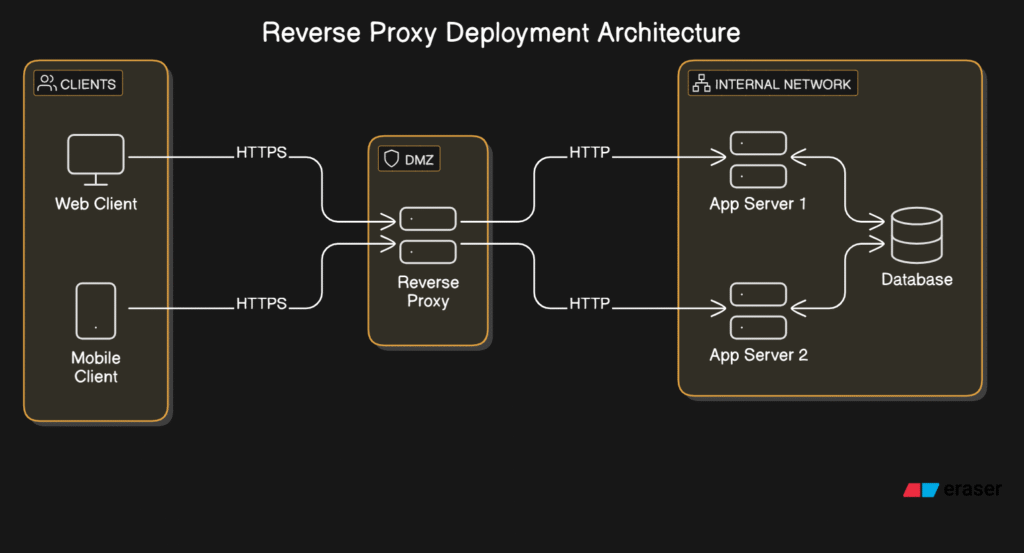📌 Introduction
A Reverse Proxy is a crucial component in scalable systems, enabling efficient request routing,
security enforcement, and performance optimization. It helps ensure reliability, scalability, and centralized
control over traffic to backend servers. This guide will cover everything you need to know about Reverse Proxies,
from the basics to real-world use cases.
⚙️ What is a Reverse Proxy?
A Reverse Proxy is a server that sits in front of backend servers and forwards client requests to
them. It acts as an intermediary, receiving incoming traffic, processing it, and then sending it to the appropriate
internal service. Unlike a forward proxy, which sits between a client and the internet, a reverse proxy sits between
the internet and the internal services.
🧩 Key Benefits
- Scalability: Distributes incoming traffic across multiple backend servers to handle high load.
- Reliability: Provides failover and redundancy mechanisms to keep services available.
- Efficiency: Caches static content and compresses data to reduce backend load.
- Security: Hides backend infrastructure and handles SSL termination, rate limiting, and DDoS protection.
🔧 Types of Reverse Proxies
- Load-Balancing Proxies: Distribute traffic evenly across multiple servers (e.g., NGINX, HAProxy).
- Caching Proxies: Store and serve frequently accessed content (e.g., Varnish).
- SSL-Terminating Proxies: Handle HTTPS encryption/decryption to offload backend servers.
- Security Proxies: Act as application firewalls or DDoS mitigators (e.g., Cloudflare).
📊 Architecture

– Reverse Proxy: Handles all client requests and routes them to the appropriate backend.
– App Server: Processes business logic, data operations, and returns the result.
🔁 Use Cases
- Microservices Architecture: Acts as a unified entry point for multiple internal services.
- Static Content Delivery: Caches and serves static assets quickly, reducing load on app servers.
- Security Filtering: Implements WAF (Web Application Firewall) rules and SSL termination.
- Multi-Tenant Systems: Routes traffic to different apps based on URL, hostname, or headers.
⚙️ Tools & Services
- Open-Source Tools:
- NGINX: A popular and high-performance reverse proxy and load balancer.
- HAProxy: A reliable reverse proxy for TCP and HTTP applications.
- Cloud-Native Solutions:
- AWS ALB (Application Load Balancer): Routes requests based on content and path.
- Cloudflare: Acts as a global reverse proxy with DDoS protection and caching.
✅ Best Practices
- Enable Caching for Static Assets: Improve performance by reducing load on backend services.
- Implement Health Checks: Monitor backend services to reroute traffic during failures.
- Use HTTPS & SSL Termination: Secure all incoming requests at the proxy level.
- Rate Limiting & IP Whitelisting: Prevent abuse and ensure secure access control.
🔐 Security Implications
- DDoS Protection: Reverse proxies can absorb and mitigate large-scale attacks.
- Hide Internal Architecture: Prevent direct access to backend services for added protection.
📚 Real-World Examples
- Netflix: Uses NGINX-based reverse proxies for traffic routing and scaling video services.
- GitHub: Uses HAProxy to distribute load and ensure high availability across services.
- Cloudflare: Acts as a global reverse proxy, enhancing speed and security for millions of websites.
🚀 Conclusion
Reverse Proxies are an essential part of any modern, scalable system architecture. They manage traffic, enhance
security, balance load, and provide centralized control over application flow. Understanding and leveraging reverse proxies can significantly improve both performance and reliability in distributed systems.
3 FAQs About Reverse Proxy
- What is the primary function of a Reverse Proxy?
To forward client requests to backend servers and return the response, acting as a gateway to internal services. - How does a Reverse Proxy improve performance?
By caching content, compressing responses, and distributing load across servers. - What are common challenges with Reverse Proxies?
Misconfigurations, SSL certificate management, and ensuring low latency under high load are typical concerns.

